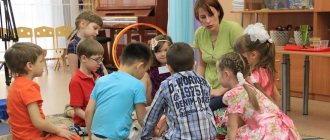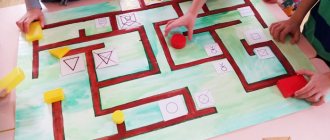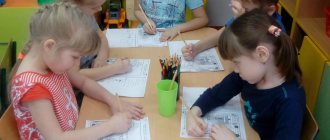What conditions for communication does the game provide for children?
In preschool age, play is the main form of children's activity, the leading activity that stimulates the all-round development of the child. The vast majority of games are designed for partnerships and collective interactions.
If a child wants to express himself in any role, he needs partners; wants to run and jump - needs accomplices in active action.
Such activities involve interaction, communication, communication both with each other and in a group of children.
The game has a set of requirements and characteristics that are directly related to the development of communication.
- The need to establish connections with other children, to communicate something, to ask about something.
- Ability and willingness to work together.
- Opportunities to take the initiative and convince peers to take part in the game or agree with the proposal of a rule, etc.
- Willingness to submit to the demands of the team and change one’s behavior.
- The need to take into account the opinions of others.
- The ability to find your place in the game and communicate during actions.
- Willingness to show attention and emotional support to peers.
- The need to control your behavior, statements, outbursts of emotions.
Communication in a person’s life performs three main functions: information and communication, regulating relationships and ensuring the emotionality of relationships (affective-perceptual). If we analyze the above list, it becomes obvious that for each of the communication functions there is a place for development in the play activities of preschoolers.
Children's play as a medium for the development of all aspects of communication
Let's consider how the conditions of the game provide preschoolers with opportunities to develop communication skills in terms of the basic functions of communication.
Development of information and communication function
If in ordinary conversations children speak without really listening to the other, then the game situation significantly reduces such chaos. A situational business form of communication is emerging.
Whether it is necessary to agree on what game will be played, assign roles or discuss the rules - preschoolers try to listen to the speaker. In a group of children there are always those who interrupt without listening to the end and shout out their suggestions. Other children stop such screamers, ask them to be silent, and order them back: “Let me listen!”
Following the plot, preschoolers strive to perform roles in a way that conveys the nature of the relationship, rather than simply performing actions. Role-playing speech addressed to game partners is actively used. Dialogues often develop between the characters in the plot. This is great communication training.
In older preschool age, the content of the game is often the relationships between people and the rules governing behavior and communication. For example, while pretending to be at school, one of the preschoolers acts as a strict teacher, makes comments to the students, and strictly follows the educational regulations.
Thus, thanks to inclusion in the game, children exchange information, learn a lot of new things, gain experience in effective communication, and have the opportunity to speak out themselves and hear others.
Formation of interaction skills
A preschooler's mastery of the world of relationships largely occurs through imitation of others. The most important practical task for a preschooler is to learn to act together, coordinating his desires and actions with the activities of his peers.
The older the preschooler, the greater his desire to play together. He may even agree to roles that are of little interest to him in order to get involved in collective activities.
It is interesting that other mechanisms then come into play: when choosing a partner within the framework of the plot, children do not want a random choice, but offer to play together with someone with whom they have already established friendly relations or have shown common interests.
As an example, a girl may agree to be not a flight attendant (an attractive role), but a passenger, but at the same time she will invite her friend to be a “passenger”. And only after this will he become much more enthusiastic about playing a role that initially did not arouse much interest.
Plot-based role-playing game creates conditions for children to simultaneously develop role-playing and real-life relationships. In role-playing games they train “as they should,” but in real ones they behave the way they want.
When children speak in accordance with the chosen role, they reflect their ideas about the style and nature of relationships. Every day they see how their parents communicate, how other adults interact, and imitate them in accordance with the game plot.
It is interesting to watch how a preschooler steps out of his role for a minute and begins to express his comments that someone is behaving differently, or that the rules of the game do not correspond to how it happens in life.
Development of the emotional sphere and children’s perception of each other
The situations played out by children are made up for fun, but the feelings experienced in the game are real, real.
In play, a child can express himself in ways that he would not dare to behave in everyday interactions with peers. This is especially true for timid children. Adults who organize or supervise preschoolers’ games should encourage timid children to also take leading roles. This will not only open up the child’s potential, but will also allow other children to see a new side of their peers.
In children's games there is a lot of expression, laughter or violent indignation. The preschooler learns to manage his behavior and emotionality, and masters the moral norms of relationships.
Preschoolers quarrel quite often when playing. Especially at the stage of distributing roles, establishing rules, and developing the plot. The reason for these quarrels is differences in the presentation of actions and the nature of the game. For example, one child believes that their play “store” should copy a self-service supermarket, while another insists that the “salesperson” weighs, accepts “money”, etc.
Those who argue have to compromise and come to an agreement. Otherwise the game will not take place. Moreover, preschoolers resolve such disputes themselves, without turning to adults. This is how they learn to give in, agree with different opinions, cope with resentment, and make their first attempts to analyze their behavior and the actions of other children.
Development of communication skills in young children through the organization of play activities
The child’s need to communicate with each other arises already in the 3rd year of his life. Early forms of communication largely determine their further development and influence a person’s personality, his attitude towards people around him, towards himself, towards the world. If a child’s ability to communicate in childhood is not sufficiently developed, then in the future he may experience interpersonal and intrapersonal conflicts.
Children communicate with peers mainly through joint games, which become a unique form of social life for them. Therefore, the problem of forming children's relationships cannot be considered without organizing meaningful play activities that instill effective communication skills, develop a sense of community, teach them to correctly express their thoughts and build dialogues, and fulfill children's need for communication. Play is the leading activity in preschool age, so the problem of developing communication skills in young children through play is relevant.
Based on this, the main tasks are:
- Teaching children verbal communication
- Development of creative abilities and imagination in the process of playful communication.
- Development of communication skills in various life situations with peers, teachers, parents and other people around them
- Formation of skills in practical mastery of expressive movements (facial expressions, gestures, pantomime)
- To promote the development of the child’s emotional sphere and a friendly attitude towards others.
- To cultivate in children an interest in the people around them, the desire and ability to cooperate, to take into account and respect the interests of others, the ability to find a common solution in conflict situations, a sense of understanding and the need for communication.
Young age is the most important period in the development of a preschooler, which is characterized by high intensity of physical and mental development. At this time, the child transitions to new relationships with adults, peers, and the objective world. The teacher carefully observes how each child’s communication with peers develops and accordingly enriches the child’s experience. At this age, an adult plays a large role in the proper organization of communication. The teacher sets an example of a kind attitude towards others.
Children's games are very diverse and can have several classifications. Let us highlight only the most common types:
Role-playing game
Outdoor games
Didactic games
Board-printed games
Theatrical games
Role-playing game is the main type of games for preschoolers. During this game, the child tries on various social roles, puts himself in social situations that he could see in the real life of adults. The most common role-playing games include “Shop”, “At the Doctor’s Appointment”, “Mothers and Daughters” and many others, most of which introduce children to various professions. Develops the skill of communicating with each other, the ability to subordinate one’s interests to the interests of others.
Outdoor games - here children are very active and restless, they can realize their need for movement, improve their motor skills. Develop team relationship skills; coordinating your actions with the actions of others.
For the development of communication, didactic games play an important role, which have a certain significance in the social education of children. First, the child learns to do something around other children, without disturbing them, without taking their toys, without being distracted. Then he gets used to joint activities. Together they look at pictures, make patterns, connect puzzles. Interest in the actions of another child, joy from common actions arises.
Didactic games develop the ability to act together with a peer as a playing partner. These are games like “Whose House Is This”, “Professions”, “Whose House”, “Kids and Paints”.
Printed board games - Develop the ability to communicate, agree on the rules of the game, and follow the order of actions. There are a great many of them now. All of them are colorful and attractive for kids. These are games such as “The Adventure of Pinocchio”, “Mosaic”, “Dominoshniki”.
Theatrical games are always loved by children, because children learn, together with the characters in the plays, to experience the whole gamut of emotions that exist in real life. By participating in theatrical games, children get acquainted with the world around them. After all, while playing a role, a child passes through all the feelings, emotions, lives the life of the hero, evaluates his behavior and attitude towards others. During the game, children feel relaxed, free and actively interact with each other and adults. With pleasure, transforming into the favorite image of the hero, the baby accepts and appropriates the characteristics characteristic of him. Children's independent role-playing allows them to develop experience of moral behavior, the ability to act in accordance with moral standards, since they see that positive qualities are encouraged by adults, and negative ones are condemned.
Theatrical games develop the skill of joint activities, the desire to communicate, the ability to conduct a dialogue, and overcome shyness. The following techniques were used: dialogue poems. help children feel communication with a specific person in the conversational language familiar to children, how they talk in life (Chicken Ryabushka, why do you need water? - Give the chickens something to drink. - How do the chickens ask for water? - Pee-pee-pee) Game situations that allow the child to express their desires, interests, focusing on their own needs and the desires of other children (“The cat was offended” (the ball he was playing with was taken away from him; the children feel sorry for him, give him another ball, sing him songs). Staging fairy tales that help bring children closer together, making them allies , partners in a common cause (“Teremok”, “Ryaba Chicken”, “Turnip”).
The formation of communication skills with peers in the first stages should be based on the following principles:
- Non-judgmental. Any assessment focuses the child’s attention on his own positive and negative qualities, on the strengths and weaknesses of another, and as a result provokes comparison of himself with others. All this gives rise to a desire to please an adult, to assert oneself and does not contribute to the development of a sense of community with peers.
- Refusal of real objects and toys. Often, numerous quarrels and conflicts arise over toys. As practice shows, the appearance of any object in the game distracts children from direct communication; the child begins to see a peer as a contender for an attractive toy, and not as an interesting partner. In this regard, you should, if possible, refrain from using toys and objects in order to maximally direct the child’s attention to his peers.
- Lack of competitiveness in games. Competitions, competitive games, duels and competitions are widely used in the practice of preschool education. However, they direct the child’s attention to his own qualities and merits, give rise to strong demonstrativeness, competitiveness and orientation towards the assessment of others and, ultimately, disunity in the team. That is why, in order to form a moral principle, it is important to exclude games containing competitive moments and any forms of competition.
Thus, through play activities the following are developed:
− communication skills with peers and adults;
− relationships in the team;
− skill of joint activity;
− shyness is overcome;
− collaboration in a team.
A child who has not gone through the “school” of communicating with peers falls out of the established children's cultural environment with its unwritten laws and rules. He does not know how to speak with his peers in their language and, naturally, is rejected by them. With age, this causes additional disorders in behavior and character. The child shows his dissatisfaction in communication, becomes irritated and aggressive.
At a young age, it is difficult to teach a child to communicate with peers without the help of adults. Therefore, I wish you to be active participants in the game and show examples of cultural communication.
Literature:
- Voronova, A.P. The ABCs of Communication. Development of the child’s personality, communication skills with adults and peers. For children from 3 to 6 years old. - M.: Detstvo-Press, 2008.
- Volkov, B. S. Psychology of communication in childhood: a textbook - St. Petersburg: Peter, 2008.
- Kalinichenko, A. V. Organization of play activities of preschoolers: a methodological guide. M.: Iris-Press, 2004.
- Lisina, M. I. Development of communication between preschoolers and peers - M.: Pedagogika, 1989.
- Mikhailenko, N. Ya. Korotkova, N. A. How to play with a child: a guide for educators. - M.: Gnome, 1990.
- “Game in the correction of a child’s mental development” Textbook Moscow 1997
- Anikeeva N.P. Education through play. M.: Education, 1997. 210 p.
- Arushanova A. G. Educational field “Communication”: forms of organization of psychological and pedagogical work // Modern kindergarten. 2011. No. 2. pp. 19–26.
- Raising children through play: a manual for child educators. garden / comp. A. K. Bondarenko, A. I. Matusik. M.: Education, 1983. 192 p.
- Zvorygina E. V. Children’s first story-based games: a manual for children’s educators. garden M.: Education, 2011. 96 p.
- Mikhailenko N. Ya., Korotkova N. A. Organization of story-based games in kindergarten: a manual for teachers. M.: GNOM i D, 2000. 96 p.








